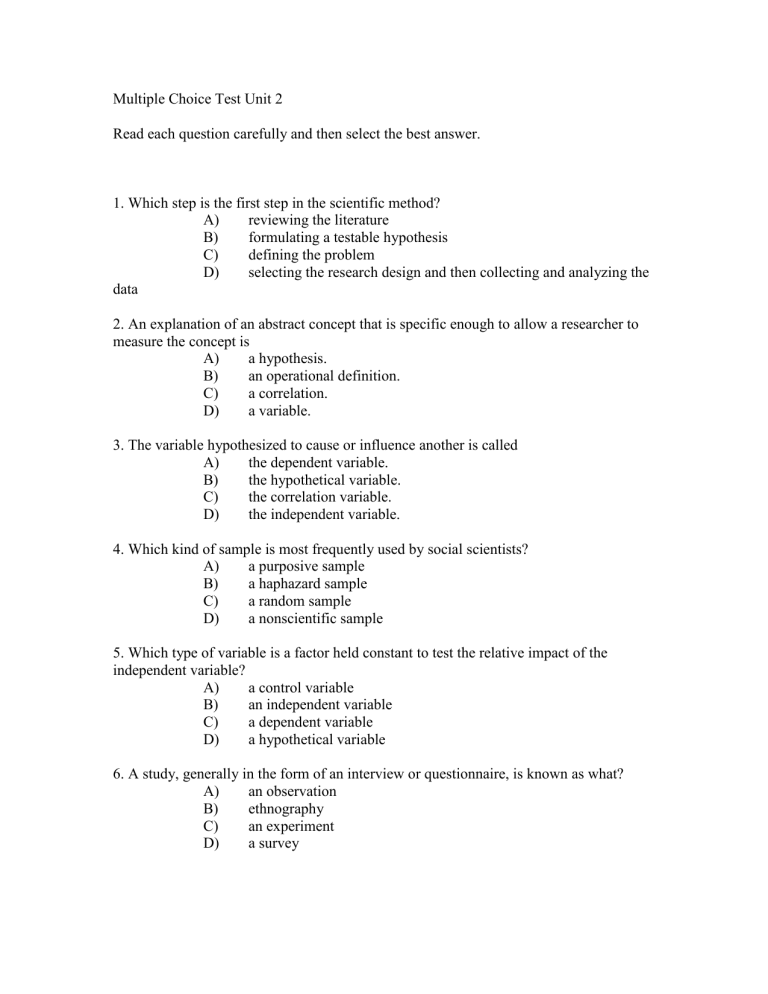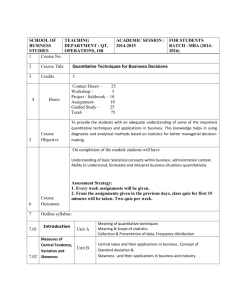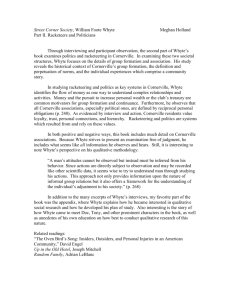Unit 2 test Sociology

Multiple Choice Test Unit 2
Read each question carefully and then select the best answer.
1. Which step is the first step in the scientific method?
A) reviewing the literature
B) formulating a testable hypothesis
C) defining the problem
D) selecting the research design and then collecting and analyzing the data
2. An explanation of an abstract concept that is specific enough to allow a researcher to measure the concept is
A) a hypothesis.
B) an operational definition.
C) a correlation.
D) a variable.
3. The variable hypothesized to cause or influence another is called
A) the dependent variable.
B) the hypothetical variable.
C) the correlation variable.
D) the independent variable.
4. Which kind of sample is most frequently used by social scientists?
A) a purposive sample
B)
C)
D) a haphazard sample a random sample a nonscientific sample
5. Which type of variable is a factor held constant to test the relative impact of the independent variable?
A) a control variable
B) an independent variable
C) a dependent variable
D) a hypothetical variable
6. A study, generally in the form of an interview or questionnaire, is known as what?
A) an observation
B) ethnography
C) an experiment
D) a survey
7. Which research technique was used by Elijah Anderson to gather information on street life in Philadelphia?
A) experimental research
B) observational research
C) survey research
D) secondary analysis
8. Anthropologists rely heavily on what type of research?
A) ethnography
B) survey research
C) secondary analysis
D) experimental research
9. When sociologists want to study a possible cause-and-effect relationship, they may engage in what kind of research technique?
A) ethnography
B)
C) survey research secondary analysis
D) experimental research
10. Durkheim's statistical analysis of suicide was an example of what kind of research technique?
A) ethnography
B) observation research
C) secondary analysis
D) experimental research
11. Max Weber argued that sociologists must practice what in their research?
A)
B)
C) subjectivity keeping the real reasons for the research secret using statistical analysis
D) value neutrality
12. What is one of the most complicating factors in researching human sexuality that is discussed in the text?
A) Most researchers are not comfortable studying human sexuality.
B) The reluctance of government agencies to provide funding for such research. behavior.
C) The difficulty in finding respondents willing to talk about sexual
D) All of the above.
13. In The Death of White Sociology, Joyce Ladner focused on what issue?
A) value neutrality
B) a statistical analysis of suicide
C) environmental protestors
hypothesis.
D) the treatment of the lives of African Americans as a social problem
14. Which of the following statements is false?
A) Sociological studies always generate data that supports the original
B) The scientific model is important because it plays a major role in the workings of our society.
C)
D)
Education affects a person's income.
Television polls are not representative samples.
15. In the 1930s, William F. Whyte moved into a low-income Italian neighborhood in
Boston. For nearly four years, he was a member of the social circle of "corner boys" that he describes in Street Corner Society. His goal was to gain greater insight into the community that these men had established. What type of research technique did Whyte use?
A)
B) experimental survey
C) secondary analysis
D) participant observation
16. The systematic, organized series of steps that ensures maximum objectivity and consistency in researching a problem is termed the
A)
B) dramaturgical approach. scientific method.
C) functionalist approach.
D) feminist view.
17. A sociologist studying prejudice views the phenomenon in terms of a person's unwillingness to hire or work with members of minority groups. This view illustrates an explanation of an abstract concept that is specific enough to allow a researcher to measure the concept and is known as a/an
A) operational definition.
B)
C) hypothesis. theory.
D) independent variable.
18. A/an __________ is a speculative statement about the relationship between two or more factors known as variables.
A) operational definition
B) theory
C) hypothesis
D) correlation
19. A measurable trait or characteristic that is subject to change under different conditions is referred to as a/an
A) A operational definition.
B) theory.
C) hypothesis.
D) variable.
20. A correlation exists when
A)
B) one variable causes something to occur in another variable. two or more variables are causally related. variable.
C) a change in one variable coincides with a change in another
D) a negative relationship exists between two variables.
21. The degree to which a measure or scale truly reflects the phenomenon under study is termed
A)
B)
C)
D) reliability. validity. sampling representativeness. predictability.
22. Which of the following is NOT a form of survey?
A) interview
B) questionnaire
C) observation
D) All of the above are forms of surveys.
23. Which of these is NOT an arena where feminists are most likely to focus their ethnographic research?
A) Playgrounds
B)
C)
D)
Street corners
Grocery stores
Front stoops
24. The term ___________ refers to subjects of observational research who deviate from their typical behavior because they realize that they are under observation.
A) Hawthorne effect
B) causal logic
C) secondary analysis
D) none of the above
25. Which of these was NOT a procedure used by the National Health and Social Life
Survey (NHSLS) to ensure the validity of its findings on human sexuality? matter
A) interviews conducted in person
B) participatory observation
C) confidential survey that included questions about sensitive subject
D) redundant questions at different times in different ways during 90minute interview










